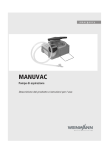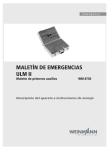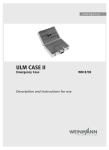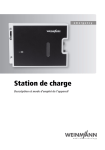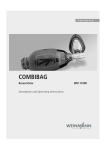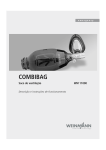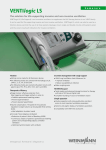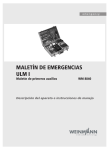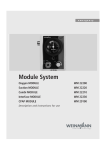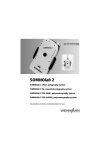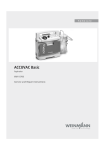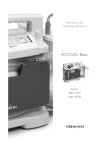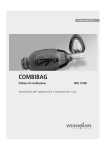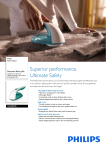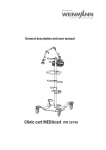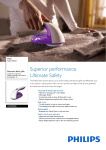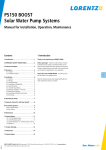Download Instructions for use MANUVAC
Transcript
MANUVAC Suction Pump Description and instructions for use Contents 1. Overview . . . . . . . . . . . . . . . . . . . . . . . . . . . . . . .3 1.1 Special symbols on the device . . . . . . . . . . . . 4 2. Description . . . . . . . . . . . . . . . . . . . . . . . . . . . . .5 2.1 Purpose . . . . . . . . . . . . . . . . . . . . . . . . . . . 5 2.2 Function . . . . . . . . . . . . . . . . . . . . . . . . . . 5 3. Safety Instructions . . . . . . . . . . . . . . . . . . . . . . . .6 4. Use 4.1 4.2 4.3 . . . . . . . . . . . . . . . . . . . . . . . . . . . . . . . . . . .8 Putting into operation . . . . . . . . . . . . . . . . . . 8 Aspiration . . . . . . . . . . . . . . . . . . . . . . . . . 9 After aspiration . . . . . . . . . . . . . . . . . . . . . 11 5. Hygienic preparation . . . . . . . . . . . . . . . . . . . . .12 6. Functional check . . . . . . . . . . . . . . . . . . . . . . . .13 7. Troubleshooting . . . . . . . . . . . . . . . . . . . . . . . . .14 8. Maintenance . . . . . . . . . . . . . . . . . . . . . . . . . . .15 8.1 Intervals . . . . . . . . . . . . . . . . . . . . . . . . . . 15 8.2 Disposal . . . . . . . . . . . . . . . . . . . . . . . . . 15 9. Product and accessories . . . . . . . . . . . . . . . . . . .16 9.1 Standard product . . . . . . . . . . . . . . . . . . . 16 9.2 Accessories . . . . . . . . . . . . . . . . . . . . . . . 16 9.3 Spare parts . . . . . . . . . . . . . . . . . . . . . . . 16 10. Technical Data . . . . . . . . . . . . . . . . . . . . . . . . . .17 11. Warranty . . . . . . . . . . . . . . . . . . . . . . . . . . . . . .18 12. Declaration of Conformity . . . . . . . . . . . . . . . . . .19 2 EN 1. Overview 10 Grip bar 9 Housing groove for suction hose 8 Discharge valve 7 Pedal 6 Suction valve 5 Holding clip for secretion bottle 4 Connecting hose 3 Angled hose connection 2 Secretion cap with overflow protection and vent flap 1 Secretion bottle 11 Suction pump 12 Retaining clip 18 Vent flap 17 Adapter n.d.10 16 Thick suction hose (length 280 mm, 2nd stage) 13 Fine suction hose (length 1020 mm, 1st stage) 14 Adapter n.d.6 15 Secretion socket with fingertip control Overview EN 3 1.1 Special symbols on the device 1 No. Symbol Meaning MANUVAC device information plate SN Serial number of device Year of manufacture 1 CE marking 4 EN Overview 2. Description 2.1 Purpose The MANUVAC aspirator is a vacuum pump, independent of an energy source, which can be operated manually or with the foot or knee. The MANUVAC aspirator is a vacuum device for use outdoors, used in medical technology, especially emergency medicine, to aspirate significant accumulations of blood, mucus, saliva etc. as well as viscous and solid food particles. This prevents airways becoming blocked and eliminates the risk of these substances being aspirated into the lungs. In addition, the MANUVAC vacuum pump can be used to evacuate vacuum mattresses. MANUVAC is not intended to be used for bronchial aspiration. 2.2 Function Rhythmic depression of the pedal creates a negative pressure via a diaphragm, which sucks the material from the patient’s oral-/pharyngeal cavity through the 2-stage suction hose into the secretion bottle. The 1st stage of the hose system is used to aspirate blood, secretions, mucus etc., the 2nd stage for effective aspiration of viscous and solid food particles. The two suction hoses will bridge a distance of 1300 mm between the patient and the device. Description EN 5 The secretion bottle is portable, i.e. it can be removed from the pump if required. This means that when aspirating directly via the thick suction hose, the distance to the patient may be up to approx. 950 mm. The secretion cap on the secretion bottle is equipped with an overflow protection device to prevent the contents from overflowing into the vacuum pump. The pedal automatically returns to the starting position via a spring. 3. Safety Instructions For your and your patient's safety as well as in accordance with offi cial Safety Regulations (Directive 93/42 EEC) we may point out the following: 6 EN Safety Instructions • Read these operating instructions carefully. They belong to the appliance and must be kept available at all times. • Any use of the appliance is subject to detailed knowledge and consideration of these Operating Instructions. • MANUVAC must be used for the designated purpose only (see "2.1 Purpose" on page 5). • Observe the section “5. Hygienic preparation” on page 12 to avoid infection or bacterial contamination. • If third-party items are used, functional failures may occur and fitness for use may be restricted. Biocompatibility requirements may also not be met. Please note that in such cases, any claim under warranty and liability will be voided if neither the accessories nor genuine replacement parts recommended in the instructions for use are used. • MANUVAC may only be used by trained staff instructed in aspiration techniques. Incorrect use can cause serious bodily harm. • During the aspiration process, take particular care not to cause injuries to the patient’s mouth or throat, e.g. to mucous membrane. The suction can be interrupted by briefly opening the fingertip, for example if the nozzle becomes firmly attached to the skin. Important! • Dispose of fluids such as blood and secretions, together with any parts contaminated by them, in accordance with national hygiene guidelines. Safety Instructions EN 7 4. Use The MANUVAC vacuum pump is supplied fully assembled and is quickly and easily put into use. 4.1 Putting into operation 1. Place the vacuum pump on a strong, steady base. The red vent flap must be closed. 2. Gently depress the pedal and push the retaining clip outwards. The pedal then springs up into the starting position. 3. Lift the thick suction hose out of the curved housing groove. 4. Aspiration is carried out by rhythmic depression of the pedal with the hand,foot or knee. Always operate the pedal as smoothly and steadily as possible. For manual operation, grasp the grip bar on the front of the pump with the fingers and pump with the ball of the thumb. 8 EN Use 4.2 Aspiration During the aspiration process, take care not to cause any injury to the patient’s mouth and throat region, and especially to mucous membrane. • For tracheal and nasopharyngeal aspiration, aspiration catheters of various sizes can be fitted to the suction hose via the conical adapter on the secretion socket. • The fingertip on the secretion socket can be opened to interrupt suction briefly, e.g. if the nozzle is clinging to the skin. You can leave the fingertip open all the time and keep your thumb over it. To release the suction all you have to do is lift your thumb. • For effective aspiration of viscous and solid food particles, simply insert the thick suction hose (2nd stage) directly into the patient’s oral-/pharyngeal cavity, removing the fine suction hose (1st stage) with the adapter from the thick suction hose (2nd stage). • To bridge a distance between the MANUVAC vacuum pump and the patient via the thick suction hose (2nd stage), the secretion bottle can be removed from the clip. The connecting hose does not affect the suction capacity. Use EN 9 • The red vent flap should always be open (Fig.8) during direct aspiration with the thick hose (2nd stage). The suction is built up by closing the vent duct with the index finger and can also be regulated by opening and closing this duct. • Should the thick aspiration hose (2nd stage) be sucked onto the patient’s tongue or mucous membranes, the vent duct in the secretion cap must be opened by lifting the index finger or the red vent flap reopened. Suction is then interrupted immediately and the aspiration hose freed. Pumping by hand, foot or knee can be continued throughout. • During aspiration, the secretion bottle must be placed or held upright (secretion cap pointing upward). If nessary, the secretion bottle can also be held vertically or obliquely, however, the secretation cap must point upwards. If the secretion cap is held downwards, the overflow protection device seals off the connection to the vacuum pump. If this happens, you should hold the secretion cap pointing upwards again and interrupt the aspiration process for a few seconds by opening the red vent flap on the secretion cap until the safety ball falls back again. • Once the secretion bottle is full, the overflow protection device cuts off the suction process and the pedal can be operated only with considerable difficulty. The secretion bottle should then be emptied immediately as follows: – – – – 10 EN Use Remove the secretion cap Empty the secretion bottle Replace the secretion cap Continue to aspirate. 4.3 After aspiration 1. After completing the aspiration, empty the secretion bottle and rinse it, together with the secretion cap and the suction hoses with clear water on the spot. 2. Then replace the secretion cap so that the triangular mark points to the upper middle line of the secretion bottle, then fit the hoses together. Important Unless absolutely unavoidable, the vacuum pump should never be transported with a full secretion bottle, since the aspirated liquid could run out. 3. Tightly wind the connecting hose in the direction of the arrow around the bottom of the secretion bottle and return the bottle to the holding clip. 4. Place the thick suction hose in the housing groove, depress the pedal and secure it with the retaining clip. Use EN 11 5. Hygienic preparation This product contains disposable items. Disposable items are intended to be used only once. So use these items only once and do not reprocess them. Reprocessing disposable items may impair the functionality and safety of the product and lead to unforeseeable reactions as a result of ageing, embrittlement, wear, thermal load, the effects of chemical processes, etc. After every aspiration process, hygienic preparation of the MANUVAC aspiration pump and the accessories used is essential. We recommend immediate cleaning with clear water (on the spot if possible). Wiping with disinfectant is sufficient for the external surfaces. Observe the instructions regarding use of disinfectant. For immersion disinfection we recommend GIGASEPT FF and TERRALIN® for wipe disinfection. You are recommended to wear suitable gloves (e.g. household or disposable gloves) during disinfection procedures. Make sure you perform a functional check after every hygienic preparation (see "6. Functional check" on page 13). If, despite the overflow protection device, secretions, blood, mucus or the like should pass into the interior of the pump (the inside of the connecting hose will show signs of contamination), it is necessary to clean the interior – the pump chamber – with a commercial disinfectant solution (GIGASEPT FF) as follows: 1. Remove the connecting hose with angled hose connection from the secretion cap and suspend it in a disinfectant solution. 2. Operate the pedal until the disinfectant solution emerges from the discharge valve. 12 EN Hygienic preparation 3. Take the hose out of the disinfectant solution, hold the vacuum pump high and again operate the pedal until all the disinfectant solution is forced out of the pump. In case of serious contamination, we recommend a precleaning with clear water. Procedure is the same as for rinsing with disinfectant solution. The pump does not need to be dismantled for this cleaning operation. Important The time of exposure to the disinfectant solution must be adhered to. Unsufficient disinfection can lead to danger of infection. The two-part hose system with adapters, the secretion cap and the secretion bottle can also be cleaned in a disinfectant solution. All parts must be rinsed thoroughly with clear water and dried sufficiently after every disinfection. The secretion bottle can be autoclaved at up to 121°C/250°F. 6. Functional check To guarantee satisfactory operation of the MANUVAC vacuum pump, the function must be checked every time the pump is disinfected and sterilised. Procedure: • Ensure that the hose connections are tight. • Check that the hoses and rubber parts are in good condition. Porous and brittle parts must be replaced. • Check the aspiration by periodically operating the pedal and simultaneously opening and closing the suction opening of the secretion socket with the thumb. Functional check EN 13 7. Troubleshooting Fault Cause Remedy Check that aspiration line, connecting line and secretion bottle cap all fit tightly. Check that the fingertip cap of the secretion socket fits tightly. Suction too low. Leaks in the System. Check that the red vent flap of the secretion bottle fits tightly. Check the disk diaphragm for cracks and replace if necessary (see chapter “8. Maintenance” on page 15). Check the hose system and rubber parts for cracks and replace if necessary. No suction, pedal very difficult to operate. Secretion bottle full. Overflow protection device has cut in. Empty secretion bottle. Incorrect operation has caused overflow protection device to cut in. Hold secretion bottle upwards. Interrupt aspira-tion for a few seconds by opening the red vent flap on the secretion cap until the ball float has dropped down. Hose system has been blocked with secretions during aspiration. Clean the hose system with water. If the fault cannot be remedied, it is advisable to contact the manufacturer Weinmann or return the set to the works for overhaul. Do not continue to use the vacuum pump since this could lead to serious damage. 14 EN Troubleshooting 8. Maintenance 8.1 Intervals The MANUVAC vacuum pump requires no maintenance other than observation of the cleaning and function instructions. However, the disk diaphragm should be examined every 2 years. Procedure: • Unscrew the four support feet and remove the base plate, so that the disk diaphragm can be seen. • The disk diaphragm should be regarded as functioning satisfactorily if no cracks or other defects can be seen. Should it be found to be defective, it can easily be changed by authorized specialist staff. • Have servicing and repair work performed only by the manufacturer, Weinmann, or qualified expert staff. 8.2 Disposal Do not dispose of the unit with domestic waste. To dispose of the unit properly, please contact a licensed, certified electronic scrap disposal merchant. This address is available from your Environment Officer or from your local authority. The unit packaging (cardboard box and inserts) can be disposed of as waste paper. Maintenance EN 15 9. Product and accessories 9.1 Standard product MANUVAC vacuum pump with secretion bottle, connecting hose and suction hoses WM 10800 9.2 Accessories The following accessories are not part of the standard product and must be ordered separately: Aspiration catheter, sterile pack of 2 pcs., 50 cm, Ø 2.0 mm, Ch.06 WM 5155 Aspiration catheter, sterile pack of 4 pcs., 50 cm, Ø 3,3 mm, Ch.10 WM 5157 9.3 Spare parts 16 EN Suction hose set for the MANUVAC WM 15116 Secretion bottle WM 10821 Secretion cap, complete WM 10822 Secretion cap WM 10823 Vent flap WM 10825 Disk diaphragm WM 10842 Hose, silicone, diam. 6/10 mm, length 1020 mm WM 10801 Product and accessories Hose, steramide, diam. 4/7 mm, length 740 WM 5776 Hose, silicone, diam.10/15mm, length 280 mm WM 2201 Adapter, n. d.10 WM 4627 Angled hose connection WM 2252 Secretion socket with fingertip control WM 2251 Adapter, n. d. 6 WM 2261 Return flow protection device WM 2281 10. Technical Data MANUVAC Appliance class 93/42/EEC I Dimensions (WxHxD) in mm 205x105x175 Weight approx. 1.4 kg Suction volume 160 ml/stroke Max. negative pressure –700 mbar Volume of secretion bottle 370 ml Temperature range – Operation – Storage –18 °C to +50 °C –40 °C to +60 °C Overflow protection device ball float Connecting hose length 740 mm, 4 mm diam. Suction hose, complete – Suction hose,1st stage – Suction hose, 2nd stage length 1300 mm length 1020 mm, 6 mm diam. length 280 mm, 10 mm diam. (Subject to changes in design and equipment) Technical Data EN 17 11. Warranty 18 EN Warranty • Weinmann offers a warranty that the product, when used in accordance with requirements, will remain free from defects for a period of two years from date of purchase. For products whose durability is clearly indicated as less than two years, the warranty expires on the expiration date indicated on the packaging or in the user’s manual. • Claims against the warranty can be made only when accompanied by the sales receipt, which must show salesperson and date of purchase. • We offer no warranty in the case of: – Disregard of usage instructions – Operating errors – Improper use or improper handling – Third-party intervention by non-authorized persons for the purpose of device repair – Acts of God, e.g., lightning strikes, etc. – Transport damage as a result of improper packaging of returned items – Lack of maintenance – Operational and normal wear and tear, which includes, for example, the following components. – Filter – Batteries / recheargable batteries – Articles for one-time usage, etc. – failure to use original spare parts. • Weinmann is not liable for consequential harm caused by a defect if it is not based on intention or gross negligence. Weinmann is also not liable for minor physical injury to life or limb resulting from negligence. • Weinmann reserves the right to decide whether to eliminate defects, to deliver a defect-free item or to reduce the purchase price by a reasonable amount. • If Weinmann rejects a claim against the warranty, it assumes no expense for transport between customer and manufacturer. • Implied warranty claims remain unaffected by these changes. 12. Declaration of Conformity Weinmann Geräte für Medizin GmbH + Co. KG declares herewith that the product complies fully with the respective regulations of the Medical Device Directive 93/42/EEC. The unabridged text of the Declaration of Conformity can be found on our website at www.weinmann.de Declaration of Conformity EN 19 Weinmann Geräte für Medizin GmbH+Co. KG P.O.Box 540268 • D-22502 Hamburg Kronsaalsweg 40 • D-22525 Hamburg T: +49-(0)40-5 47 02-0 F: +49-(0)40-5 47 02-461 E: [email protected] www.weinmann.de Weinmann Geräte für Medizin GmbH+Co. KG Siebenstücken 14 D-24558 Henstedt-Ulzburg T: +49-(0)4193-88 91-0 F: +49-(0)4193-88 91-450 WM 16031h - 11.2010 Center for Production, Logistics, Service




















